


 |
 |
 |
|||
|
|
|||||
| Bar Hopping -- Tips for making a safe bar crossing | ||||
|
By: Mark Tilden, Koinonia (Selene 5920) Editor's Note: This article is re-published with the permission of Passage Maker magazine from the April 2009 issue. Photos are courtesy of the US Coast Guard and the Columbia River Bar Pilots. One of Alfred, Lord Tennyson’s more well-known poems uses a bar crossing as a metaphor for the process of dying—passing from one world to another. Tennyson’s choice of comparisons in “Crossing the Bar” is fitting, because transiting a bar between an ocean and a river or harbor can be one of the most intimidating experiences a boater faces. More than a few boaters, myself included, have seen the steep seas on a bar and wondered if this might be the end.
A bar is a shallow area of sand or mud, usually deposited near the mouth of a bay or river. When a fast-moving river slows down to meet the ocean, it deposits tons of silt and mud that it carries. This bar forms a natural barrier, typically extending across the river or bay entrance, often at roughly right angles to the river current and the prevailing ocean swell and wind. The West Coast of the United States is dotted with notoriously dangerous bars, including what is widely considered one of the most perilous in the world: the infamous Columbia River bar, nicknamed “The Graveyard of the Pacific.” Since 1792, approximately 2,000 ships have sunk on or near the Columbia Bar. However, potentially dangerous bars can be found all over the world. In the case of the Columbia River bar, the area of shallow water extends for several miles around the mouth of the river and forms dangerous sand spits on both the north and south sides of the channel. The seas along a bar often are much larger and steeper than the ocean swell and wind waves outside the bar and the calmer waters in the bay or river. The normal river current flowing out of the mouth, accelerated by an outgoing tide, collides with the incoming swell from the ocean over this shallow water, creating extremely steep breaking waves, even on days of relatively calm weather. Add powerful current, large areas of dangerously shallow water, and tricky navigation with channels that may shift frequently, and you have a recipe for disaster.
However, crossing a bar in a small, seaworthy vessel is not an insurmountable task. While having local knowledge is always a significant advantage, safe bar crossings are not out of the reach of any prudent, well-prepared mariner armed with good information. There are a few simple guidelines you can follow that—when applied with appropriate judgment and good seamanship—can make a bar crossing safe, and even enjoyable. IT’S ALL IN THE TIMING The first and most important consideration for crossing most bars is timing. Bar conditions are strongly influenced by tides. When the normal river current combines with a strong ebb tide, the outbound current can become very powerful. Current velocities on the Columbia River bar can exceed 8 knots on a large ebb tide. The current may be so strong that smaller or slower vessels simply can’t make headway against it, and it can quickly sweep a vessel into dangerously shallow water and breaking surf. Powerful current, especially during strong ebb tides, also has a dramatic effect on the sea state. During strong outgoing tides, waves get considerably larger, steeper, and closer together due to the huge volume of water flowing over the shallow sandbar. When this strong ebb current collides with large ocean swells, waves become even larger and steeper, and conditions can quickly become dangerous, even for large vessels. Often, these dangerous conditions will subside dramatically when the tide turns. Many accidents on bars are the direct result of mariners either being unaware of the tides or choosing to cross at the wrong time. The solution is relatively simple: carry a tide book and know how to read it. Many chart plotters and navigation programs also have built-in tide tables, but, just as you should always carry paper charts, it’s wise to supplement electronic tide charts with printed tide and current books.
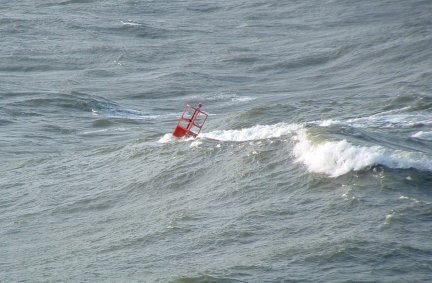 During strong ebb tides, currents can become so swift that even large buoys like this one are actually partially submerged by the current. This is Buoy 10 near the inner end of the Columbia River bar during a strong ebb tide. The main body of the buoy is completely submerged in this photo due to the powerful current.
During strong ebb tides, currents can become so swift that even large buoys like this one are actually partially submerged by the current. This is Buoy 10 near the inner end of the Columbia River bar during a strong ebb tide. The main body of the buoy is completely submerged in this photo due to the powerful current.Since most tide books are based on a select few locations, be sure you know what corrections must be applied to the tables to find the tides at the bar you intend to cross. Also, make certain that you know whether the tide tables are adjusted for daylight savings time. Don’t assume that the tide at what seems like a nearby location, especially one farther up a river, will be the same as the tide at the bar. For example, the slack tide on the Columbia River bar typically occurs about 45 minutes before slack tide at Astoria, just a few miles up the river. When is the best time to cross a bar? Actually, the easier question to answer is, when shouldn’t you cross a bar? In general, don’t cross a bar on an ebb tide. That’s when the seas will usually be the roughest, and the strongest currents will occur. Generally, the safest time to cross is during the relatively brief slack-water period between flood (incoming) and ebb (outgoing) tides. Some regions have diurnal tides (also known as daily tides), meaning that there is only one high and one low tide each day. Other areas, including the U.S. West Coast, have semidiurnal tides, with two highs and two lows each day. With semidiurnal tides, there are four slack times—when the tide is changing direction (from ebb to flood, or vice versa). Thus, there are four opportunities to cross the bar at slack water during each 24-hour period. In the process of planning your route and bar crossing, take some time to familiarize yourself with the tidal variations of the area. Compare the tides on the day you plan to cross the bar with the typical local tide swings. Will the tides be larger on the day you plan to cross? (That is, will there be a bigger variation between the high and the low?) In general, the larger the tide swing, the more likely rough bar conditions will develop because of the strong current that typically comes with larger tidal variations. While smaller variations certainly don’t guarantee smooth bar conditions, all else being equal, a smaller tidal variation often means more benign bar conditions.
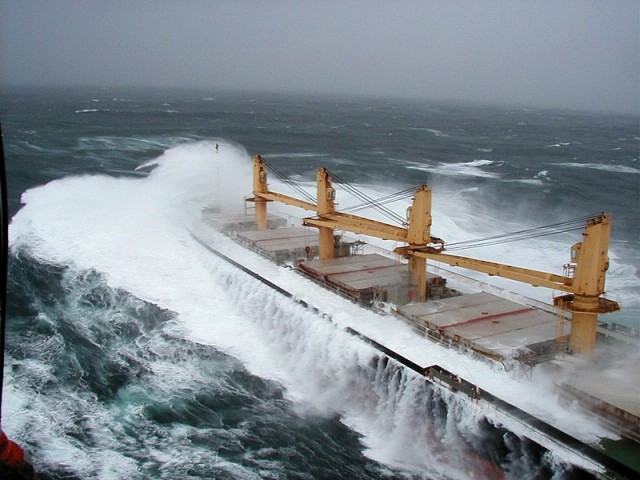 Rough bar conditions during a strong ebb can be hazardous even to large vessels. This ship is outbound on the Columbia River bar in about 40 knots of wind.
Rough bar conditions during a strong ebb can be hazardous even to large vessels. This ship is outbound on the Columbia River bar in about 40 knots of wind.With semidiurnal tides, one of the two daily tide cycles often will be considerably larger than the other. If possible, plan to cross on the smaller tide (the one with a smaller difference between the high and low tides). A lesser tide swing results in smaller ebb and flood currents and usually offers a longer period of minimal current. However, you should always avoid crossing an unfamiliar bar at night, so choosing a slack period between a larger tide swing during daylight is preferable to a slack tide in a smaller tide swing that occurs during darkness, unless you are familiar with the bar and it is well marked with lighted navigation aids. Common wisdom says that the safest time to cross a bar is during the high slack: at the end of the incoming tide, before the tide starts to go out. This is the point where the water on the bar is deepest due to the high tide, and the current should be minimal. Deeper water makes the safe channel wider and also reduces the size and steepness of the waves. However, there also are advantages to crossing on the low slack (at the end of the ebb), particularly on longer bars like the Columbia River bar, where there are several miles of potentially dangerous area and the crossing may take 30 minutes or more in a slower vessel. If you’re entering a bar from the ocean side, transiting at low slack gives you more time to cross: as the tide turns, it begins to flood, which may help by giving you a push on the way in. If you cross at high slack and it takes longer than expected, or if you run into any problems during the crossing, the tide will begin to turn to an ebb, which works against you and may even leave you on the bar during the most dangerous part of the cycle. Also, in the event that you do run aground in shallow water, if you cross at low slack, the rising tide may help lift you off the bar. In contrast, if you run aground at high tide, the falling tide will only make matters worse and may trap you on the bar during the dangerous ebb tide. River bars are also affected by runoff levels. In the spring, melting snow swells the rivers, which can increase the current during ebb tides and may decrease the current during flood tides. Familiarize yourself with the normal runoff levels for the river bar you plan to cross, and check the runoff levels during your planned crossing time. If the levels are above average, expect more severe conditions. Bar conditions also are affected by the sea state outside the bar, so if there is a large swell or significant wind waves in the ocean, the bar will most likely be rougher, as well.
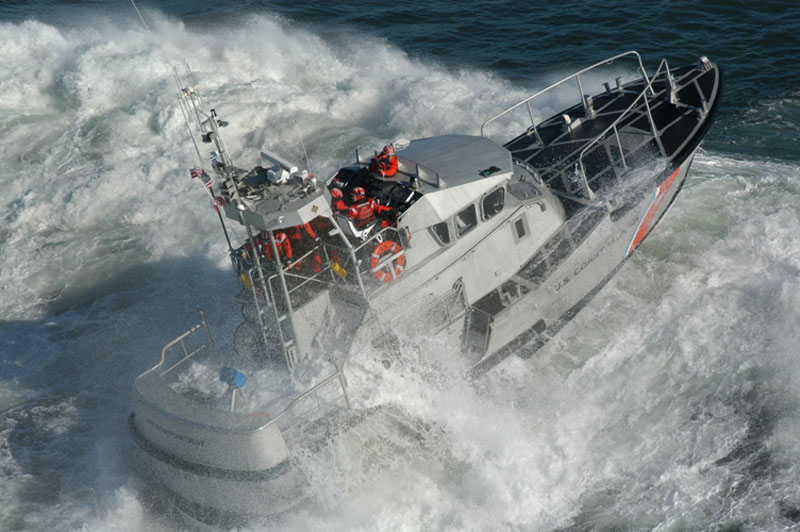 The US Coast Guard's National Motor Lifeboat school trains crews for operating in heavy surf conditions on the north end of the Columbia River bar.
The US Coast Guard's National Motor Lifeboat school trains crews for operating in heavy surf conditions on the north end of the Columbia River bar.Finally: be patient! Many accidents on bars happen when tired, cold, or seasick crew members decide to cross a bar at the wrong time. They are so anxious to get into a harbor that they “think they can make it,” even when the conditions are not suitable for a safe crossing. When it doubt, wait it out. Many times, we’ve slowed down or even made big loops outside a bar, waiting for a slack tide or better conditions. CHECK BAR CONDITIONS You’ve carefully studied the tides and planned a target time for your crossing. How do you know if conditions on the bar are safe? There are times when a bar isn’t safe to cross, even during slack current. While tides are one of the biggest influences on bar conditions, ocean swells, wind, and river runoff levels also can have a significant impact. Fortunately, bar condition reports are relatively easy to come by for most regularly traveled bars, and even for many small ones. NOAA Weather Radio broadcasts brief bar condition forecasts for many of the major bars, often including the times of maximum ebb current, which should be avoided. Be sure to keep a list of the NOAA weather stations along your planned routes. A state-by-state listing of all of NOAA’s U.S. weather radio stations is available at nws.noaa.gov/nwr/ nwrbro.htm. The U.S. Coast Guard also is a good source of information on bar conditions. Along the West Coast, there are Coast Guard stations at most major bars. Many stations have lookout towers that are high enough and close enough to the bar to observe conditions during daylight hours. Don’t hesitate to call the Coast Guard on VHF Channel 16 and request a report of bar conditions. The Coast Guard also has recorded bar condition reports for some bars available via telephone. While these recorded forecasts are not as up to date, they can be a good starting point for deciding whether it’s appropriate to even consider crossing. The phone numbers are listed through the USCG’s website; unfortunately, each Coast Guard district maintains a separate subsite, so the phone numbers aren’t always easy to find. Some bars are “regulated” by the USCG, meaning the Coast Guard may close the bar to certain sizes or types of vessels. Typically, the first vessels to be affected by these restrictions are ours: uninspected pleasure boats. The Coast Guard may impose restrictions on vessels based on size. Apart from these restrictions, the Coast Guard typically will not advise you as to whether you should cross a bar. Members of the Coast Guard will report conditions, and if they have a small vessel available in the area, they may offer to escort you across the bar. They also will tell you if the bar is restricted at the moment. However, when the bar is open, it’s your responsibility to decide when and if to cross. At some locations, bar condition warning lights are installed to provide a visual indication of whether there is any kind of restriction on the bar. Again, we haven’t found a single complete list of these locations, but the Coast Pilot and Coast Guard district websites are good places to check. Some larger bars with regular commercial traffic also have a group of professional pilots who come aboard ships and advise the master of the vessel on navigating the bar. While these pilots primarily serve large commercial vessels, they offer a wealth of experience and information. The Columbia River Bar Pilots have a helpful website (columbiariverbar pilots.com) with links to a variety of weather and tide information.
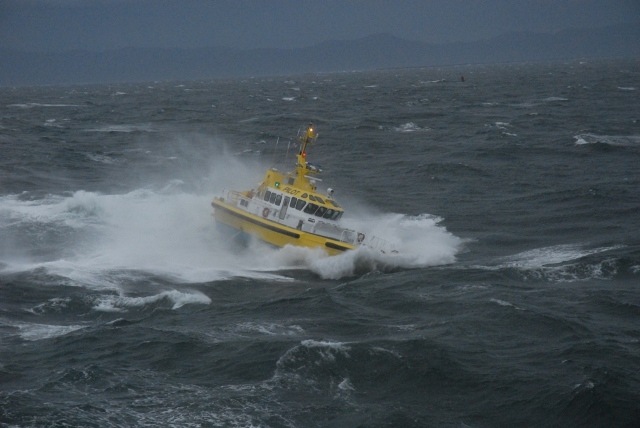 The Columbia River Bar Pilots send a boat out to bring pilots to a ship or retrieve them after the bar crossing. This is the bar pilots boat approaching a ship to pick up the pilot in rough conditions.
The Columbia River Bar Pilots send a boat out to bring pilots to a ship or retrieve them after the bar crossing. This is the bar pilots boat approaching a ship to pick up the pilot in rough conditions.If you are unsure of your skills or preparation for crossing a bar, consider hiring a captain who has specific knowledge of the bar you intend to cross. WHERE TO CROSS Generally, the safest place to cross a bar is in the main channel—assuming there is one. However, the channel location may shift dramatically, especially on bars that are not actively maintained or dredged. Many bars have large rock or concrete jetties that are designed to help direct the current flowing out of the river into a confined area and thus minimize shifting of the channel. Heavily traveled bars like the Columbia River bar are actively dredged to maintain the channel. These bar channels also are typically well marked with buoys and range markers that identify the main channel. Other bars that are smaller may not be as well marked, and some may not even have a defined channel. In general, it’s unwise to attempt to cross these unmaintained or unmarked bars without expert local knowledge and experience. Even some relatively well-marked channels, such as the Tillamook Bay bar, about 50 miles south of the Columbia River, have been subject to large changes in the channel location, particularly when jetties have been damaged by intense winter storms. When in doubt, seek out local knowledge and experience. You can learn a lot by being friendly with commercial fishermen in many of these ports, or by calling the local Coast Guard station well in advance of your planned crossing to get suggestions. If you do choose to cross a busy bar in the main channel, keep an extremely alert watch. Heavily traveled bars like those in San Francisco and on the Columbia River have nearly constant streams of commercial traffic, from freighters to fishing boats. Large ships often travel at relatively high speeds to maintain steerage, especially when crossing with the current. They will be extremely limited in their ability to maneuver and will be restricted to the channel. Be sure to give them plenty of room by sticking close to the edge of the channel. You may even be able to stray slightly outside the channel to make room for commercial traffic, but it’s important to watch the chart and your depth sounder very carefully, as areas outside the channel are subject to large variations in bottom contours. Don’t count on the soundings on your chart outside the channel. OTHER BAR HAZARDS Fog is also a common problem on many bars. The normal navigation problems associated with fog only get worse in the restricted channel of a bar. Traffic on the bar may be concentrated during the relatively short period of slack tide, so fog can be an even more significant problem when many vessels are navigating the bar at the same time. Avoid crossing an unfamiliar bar in fog. If you’re going to cross in fog, be sure you are very adept at using your radar, and you may also want to supplement it with an AIS (Automatic Identification System). Be sure that you’re aware of where you are relative to the main channel at all times so you know where to go to avoid large commercial traffic that may have to pass you in tight quarters. If you are uncertain how to safely avoid a ship, hail the ship, typically on VHF Channel 13. Be certain to hail the vessel well in advance of close quarters. Remember that the ship’s captain will have extremely limited ability to maneuver in the tight conditions on a bar, so you’ll want to make passing arrangements while you’re still a long way off. Dredges, which carry out the seemingly endless task of maintaining the bar’s navigation channel, are another common hazard on larger bars. Be sure you know how to read the day marks and lights that the dredge displays. In general, the dredge will display two green lights or two diamond shapes in a vertical line to indicate the side that is safe to pass. Remember that dredges may also have floating pipes running to shore to carry the spoils (the sand or mud dug from the bottom). These floating pipes are generally lit with orange or yellow lights, but they may be difficult to see at night because they are low and relatively dim and can easily be confused with lights on shore. If you are in doubt, hail the dredge on VHF Channel 13. PREPARING FOR THE CROSSING Getting your boat ready for a bar crossing really is not that different from preparing for any rough-water voyage. Be sure you’ve performed all the required maintenance for your engine and other systems. Check that your fuel tanks are clean and topped off. If your boat hasn’t been in rough water for a while, the violent motion of crossing a bar can stir up sediment and other contaminants in fuel tanks and cause a sudden engine failure at the most inopportune time. Change your fuel filters, and make sure your spares are easily accessible. Check that gear is stowed and secured. Secure all hatches prior to reaching the bar. Many people choose to wear personal flotation devices during a bar crossing.
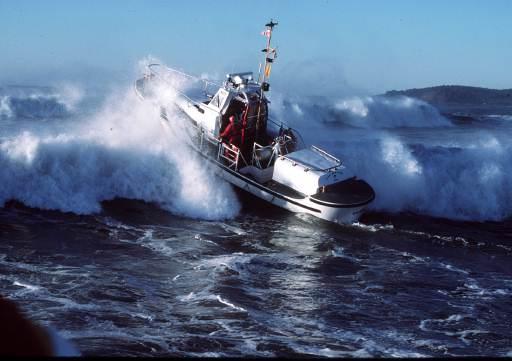 Be prepared to stay outside and not cross a bar if conditions deteriorate unexpectedly. When in doubt, stay out!
Be prepared to stay outside and not cross a bar if conditions deteriorate unexpectedly. When in doubt, stay out!If you’re planning a passage that will end with a bar crossing, such as cruising down the Washington coast from Puget Sound to the Columbia River, be prepared for a considerably longer passage than you might normally expect. If conditions deteriorate and you are forced to stay outside a bar for a full tide cycle or even several cycles, you may be at sea considerably longer than anticipated. Be sure you have sufficient fuel and provisions, and plan rest for the crew. As mentioned earlier, crew fatigue is a major contributing factor to accidents during bar crossings, because it can lead to poor decisions about when or if to cross. Again: when in doubt, stay out! Make sure that you are familiar with handling your vessel in large following or head seas. Fortunately, in most bar crossings, the seas are generally directly on the bow or stern, so it’s unlikely you’ll have to deal with significant beam seas unless you attempt to turn around on the bar—which usually is not a good idea in less-than-ideal conditions. Various sizes and types of vessels require different techniques for handling the seas, and those techniques are beyond the scope of this article. However, the key is to be very familiar with handling your boat in rough conditions before you attempt a bar crossing. The confined channel of a bar is not the appropriate setting for learning how to handle your vessel in steep seas. You’d be wise to gain that experience in a large, open body of water, where you have more room to maneuver and correct for mistakes. IN SUMMARY Crossing a bar safely requires careful planning and good seamanship, and there are great rewards for executing a successful crossing. Many beautiful, protected harbors on the West Coast and elsewhere in the world require crossing a bar. Obviously, local knowledge is always valuable, but following the guidelines discussed here will help ensure that, in the words of Tennyson, you’ll savor the “sunset and evening star” and “see your Pilot face to face” some other time. To download a PDF copy of the original Passage Maker artile, click here. Provided courtesy of Passage Maker magazine. |
||||
 
| ||||
| Copyright (c) MDT Consulting, LLC 2007. All rights reserved. | Visit the Selene manufacturer's web site | Use & Privacy Policy | Contact us | |